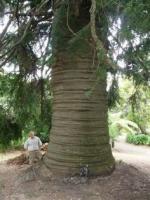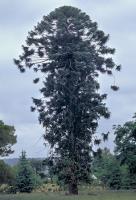Search the Community
Showing results for tags 'bunya nut'.
-
Araucaria bidwillii Hooker 1843 Common Names Known as Bunya Pine, or simply Bunya. Early settlers in Australia recorded many forms of the name used by Aboriginal peoples, including Banza-tunza, Banua-tunya, boonya, bunyi, bahnua, bon-yi, banya bunya, bunnia, bunya-bunya, and bonyi-bonyi. The similarity of these names suggests that native peoples knew it by much the same name throughout the East Coast of Australia with the variants attributable to differences in phonetic spellings. Similar variety applies to the native name for the edible nut, yenggee or jenggi Taxonomic Notes Synonymy: - Columbea bidwillii - Marywildea bidwillii First collected and described by Bidwill in 1843. The type location is in the Bunya Mountains, Queensland, Australia. Also, nineteenth-century writers called it by a number of quasi-scientific botanical names, including Bidwellianis Junus, Pinus Petrie, Araucaria bidwellia and Araucaria Bunya Bunya. This is the sole species in Section Bunya. This Section does, however, contain other fossil species, most notably A. mirabilis from the Jurassic Cerra Cuadrado forest in Patagonia. There are no Cenozoic fossils that clearly represent Section Bunya. Aboriginal Legend There are two legends concerning the Bunya pine. The Rivals' tells of a great fight between the Bunya pine (Bonyi) and the Cypress pine (Kuloloi) at Korawinga (Fraser Island). Bonyi speared Kuloloi 'low down' and the spears became the branches of the cypress pine. Kuloloi speared Bonyi 'high up', and this explains why Bunya pines growing in the scrubs have branches only at the top. In the legend of 'The Revengeful Lover' or 'How the nicks came to be on the wild plum', the Bunya pine (Bonyi) fell in love with a little tree called Kulvain that bore a bluish-black fruit like a plum. Bonyi went to Kulvain's father thinking that he only had to ask and the girl would be his. However, the father refused to give his daughter away. Bonyi then flew into a fearful rage and gashes Kulvain with his knife. That is why the fruit of Kulivan is marked all over with nicks. Observations Easily seen in Bunya Mountains National Park, Queensland. Occasionally planted as an ornamental in warm temperate parts of Australia, China, Italy, New Zealand, the United States, and probably elsewhere. Description Monoecious tree up to 50 m tall and 150 cm dbh. Crown pyramidal in younger trees, becoming conspicously dome-shaped in the mature tree, the outline of the crown defined by dense tufts of branchlets and foliage at the branch ends. As with most other Araucarias, the branches are produced from regular whorls. The bark is dark brown to black, flaking in scales up to 2.5 × 7.5 cm, on mature trees usually 5-10 cm thick and deeply furrowed. Leaves differ between juvenile and mature trees. Those of juvenile trees (or perhaps, simply leaves produced in the shade of the forest understory) are glossy, light-green, narrow, 2.5--5 cm long, and stiff with a sharp point. They are arranged in two rows on the branchlets. Leaves of mature trees (leaves produced in the crown and exposed to the sun) are arrayed radially around the branchlet (and often are overlapping), spreading, glossy, dark-green, 0.7-2.8 cm long, lanceolate or triangular-ovate, flattened, coriaceous, lacking a midvein but with numerous, parallel, thin veins; stomatal lines are abaxial. Trees begin to bear cones at about 14 years of age. The northern populations differ from the southern in that the leaves are wider and not sharply pointed. Pollen cones, usually appearing in April and maturing in September or October, are are up to 20 cm long, axillary, solitary, cylindric, produced on the ends of short lateral branches. Seed cones are produced between December and March about 17 months after pollination. The cones are unmistakeable - ovoid-subglobose, 30 × 22 cm, weighing up to 10 kg, dark green. Bracts are oblong-elliptic or oblong-ovate, margin relatively thick, wingless, apex triangular, reflexed; seed scales thickened, exposed at apex. Each cone contains 50-100 seeds that are about 2.5 cm long, elongate-elliptic, wingless, encased in a thin, tough, buff-colored integument. Distribution and Ecology Australia: Queensland Bunya pine grows in two broad geographic regions: a large area in the south-east of the State and two smaller areas in the far north. In both regions it is found in rainforest, often growing in association with hoop pine (Araucaria cunninghamii). In South-East Queensland there are five main areas where the Bunya pine occurs naturally: in the Blackall Ranges to the west of Nambour, in the upper Mary River Valley, in the ranges in the upper reaches of the Brisbane River, in the Yarraman-Blackbutt area and on the Bunya Mountains to the west of Yarraman. In North Queensland the two small stands are on Mt.Lewis and at Cunnabullen Falls. Bunya pine occurs naturally on soils that are basaltic in origin and in areas with an annual rainfall greater than 1000 mm. The species is able to tolerate temperatures ranging from -4°C to 40°C. Hardy to Zone 9 (cold hardiness limit between -6.6°C and -1.1°C). Moist conditions are required for successful germination. Germination has been recorded in humid conditions within the decomposing cones. The germination is hypogeal, meaning that the seed first produces a root and then translocates the seed's nutrients to a tuber, from which the shoot then emerges. I believe this mechanism is unique, at least among conifers, to the Bunya. A study by Smith and Butler in 2002 found that shoot emergence for seeds planted in a moist, shaded site can take a long time: 2-24 months after sowing. These delays may facilitate seedling by ensuring that some seedlings are available to take advantage of growth opportunities at any time during the approximately 3 year interval between masts. That mast interval, by the way, may be correlated with the ENSO or some other climate cycle. At maturity, the intact female cone with scales still green on the surface falls from the tree. As the cone is very heavy, and as the seeds usually remain in the cone until after it falls from the tree, seed dispersal is limited to the area covered by the cone rolling on slopes, or being transported by water flowing in creeks or gullies. The absence of effective dispersal is one likely explanation for the very restricted range of this species. The peculiar dispersal mechanism would seem to imply that, as with Pinus albicaulis of North America, there should be some sort of animal vector (perhaps now extinct) to transport the Bunya nuts. In 2007 Smith investigated this problem by tagging seeds and placing them on the ground with naturally fallen seeds, during a mast year. Some seeds were eaten by animals, but some were carried up to 8 m from the tree, sometimes in an uphill direction. Later, seeds were placed and monitored with a video camera, which recorded seed collection and dispersal by the short-eared possum Trichosurus caninus. This is the first evidence of an animal vector, other than humans, that can disperse A. bidwillii seed. It is worth considering, though, that the large, nutritious Bunya seed is well adapted to survival within the forest environment. It germinates best in moist conditions, and the generous food supply in the seed facilitates hypogeal germination, which may confer a competitive advantage to a seedling forced to compete with other seedlings trying to colonize a forest edge or gap environment. Thus the large Bunya seed may function not to lure animal dispersers, but to produce a competitive seedling. Big Tree The largest known diameter, 215 cm dbh, was measured in 2011 on a planted tree (estimated to be only 150 years old) in Bowrai, NSW. The tallest known, a tree in Bunya Mountains National Park on the Little Falls Trail, was measured in 2002 at 133 cm dbh and 51.5 m tall.. Oldest Given the great sizes that these trees have attained in cultivation, and the seeming absence of poor site conditions in their native range, it may be that none are over 300 years old. Ethnobotany The hard-shelled nuts, about 5 cm long are edible and a delicacy. The bunya was extremely important to the Aboriginal peoples within its range, and it was considered a sacred tree. About every three years, between January and March, Aboriginals used to gather for tribal ceremonies, hunting, feasting, and corroborees. The bunya feasts were traditionally held in two main areas in southeast Queensland: inland groups gathered in the Bunya Mountains near Dalby, while the coastal and hinterland people met in the Blackall Ranges. At the Bunya Mountains feasts, people came from as far south as the Clarence River in New South Wales, the Maranoa River to the west, and Wide Bay to the east. The significance of the tree has been well described. Special envoys carrying message sticks from custodians of the trees travelled through surrounding districts to invite selected groups to attend the ceremonial feasts They were times of great spiritual significance, when Aboriginal people gathered to receive strength from Mother Earth. They were also times for arranging marriages, settling disputes and for trading goods and sharing dances and songs. Aboriginal people considered the Bunya pine to be sacred, and there is scant evidence that they used parts of the tree other than the edible nuts. Curr mentions, that the headman of the Kaiabara tribe wore an armband made of bunya fibre as a mark of office and Meston states that the bark of dead trees was used as a fuel. Symons and Symons also mention that the gum and roots were a food source. The roots were peeled before being roasted. Custodians collected the nuts by climbing the trees and knocking off the cones with a stick or stone tomahawk. There were two methods for climbing trees: toe holes were cut into the bark using stone axes or trees were climbed with the aid of vines that encircled the tree and the climber. The first method is commonly given as an explanation for the characteristic large scars found on many old Bunya pines. It is of course also possible that some of these scars have been caused by large branches breaking away from the trunk or are the result of swellings caused by the growth of new shoots after old branches had died and had fallen from the tree. During the Bunya feasts, the nuts were eaten raw, roasted in the ashes or on coals or ground into flour. Other animal and plant foods were hunted and gathered on a daily basis. Together with the supply of Bunya nuts, the availability of these foods set the limits for the duration of ceremonial periods. On some occasions groups accompanying coastal groups would carry a supply of nuts with them, burying them along the way in a damp area, either in soft sand or mud or near a spring and after some time they would return to eat the nuts or, in cases where they had germinated, they would eat the tubers. Remarkably, all native stands of this tree were protected from logging by Crown decree, issued by Governor Gipps in 1842: It having been represented to the Governor that a district exists to the Northward of Moreton Bay in which a fruit-bearing Tree abounds, called Bunya, or Banya Bunya, and that the Aborigines from considerable distance resort at certain times of the year to this District for the purpose of eating the fruit of the said Tree. His Excellency is pleased to direct that no Licenses be granted for the occupation of any Lands within the said District in which the Bunya or Banya Bunya Tree is found. And notice is herby given, that the several Crown Commissioners in the New England and Moreton Bay Districts have been instructed to remove any person who may be in the unauthorised occupation of Land whereon the said Bunya or Banya Bunya Trees are to be found His Excellency has also directed that no Licenses to cut Timber be granted within the said District. This protection, however, was rescinded by the Queensland Unoccupied Crown Lands Occupation Act 1860 and exploitation of the Bunya for timber proceeded forthwith. From the 1860s timber cutters established saw mills to harvest the timber wealth of the Bunyas, with extensive cutting in the Bunya Mountains and Blackall Range. This led to the end of the great Aboriginal harvests in 1875, but began an era of intensive industrial logging that decimated the Bunya forests. During the period of commercial exploitation, from about 1860 to 1930, the timber was used for framing and boards, internal flooring, protected lining, panelling, protected structural joinery, protected non-structural joining and mouldings. Bunya pine was also used for the manufacture of butter boxes and churns, broom handles, casks, blinds, piano keys, matches, masts, booms and spars of boats, and dashboards and springboards of horse-drawn vehicles. The logging remained controversial, however, in 1908, concern over the fate of the big trees led to creation of the 9303 hectare Bunya Mountains National Park, the second national park established in Queensland. The park was subsequently expanded to include 11,700 ha of National Park and 7,790 ha of Forest Reserve. The last sawmill on the mountain closed in 1945, and since that time, human use of Bunya pine in its native range has focussed on its value as wildlife habitat and as a source of aesthetic pleasure. There is minimal interest in exploitation of the Bunya, with less than 1,000 ha currently in forest plantations; most contemporary use is for craftwood and to exploit the nuts as a delicacy. Remarks The epithet bidwillii honors John Carne Bidwill (1815-1853), an English-born Australian botanist who became the first director of the Royal Botanic Gardens, Sydney. The tree was named by William Jackson Hooker after Bidwill took the unusual step of bringing a living specimen from Australia to London. Bidwill is also remembered in the New Zealand conifers Halocarpus bidwillii (Podocarpaceae) and Libocedrus bidwillii (Cupressaceae), and is the only botanist to be honored in the names of so many conifers. In 1838, Andrew Petrie, explorer and Foreman of Works at the Moreton Bay convict settlement, became the first free settler to see the tree. Guided by a group of Aboriginal people to the Blackall Range, known then as the 'Bunnia Bunnia' Range, Petrie was so impressed, that he collected a sample of wood and made a sketch of the tree, which he called the 'bony-i'. After this visit the tree became known in the settlement as Petrie's pine or Pinus petrieana. There is an Aboriginal myth associating Andrew Petrie's later blindness with the bunya pine. The Turrbal and Kabi people (Aboriginal tribal groups in South-East Queensland) considered that Petrie's blindness was the work of spirit forces punishing him for what he had inflicted on the Bunya pine through his commercially motivated search for seedlings and samples of the tree.
- 10 replies
-
- 3
-

-

-
- bunya pine
- bunya nut
-
(and 1 more)
Tagged with:
-
I think I have found the right place to ask my questions about bunya nut trees. araucaria bidwillii aka. Bunya Bunya Question 1) What is the proper nut collection method? 2) What is the proper preparation for eating the nut? 3) Is the tree sap used for anything like glue, food, poison? 4) What are the spiritual attributes already given unto this tree. I have found it hard to find information on this common species, as to it's traditional uses. I have taste tested the sap and found it O.K. Swallowed some and never felt sick! I found the nuts tasted better cooked than raw. Any one else! Please note: I am Aboriginal and vow to hold any traditional secrets, safe. Private message me if not sure who to trust. Any info welcomed
- 30 replies
-
- 1
-










